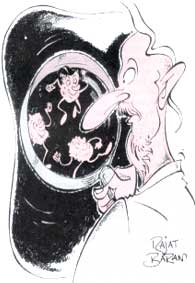Jump, they say
 JUMPING genes, also known by other names (one of them being "transposable elements"), are quite extraordinary in themselves. These fragments of parasitic DNA found within the genetic material of almost all organisms, can jump from one gene sequence to another with no apparent difficulty. Their existence implies that genetic material of an organism is unstable and undergoing a kind of flux.
JUMPING genes, also known by other names (one of them being "transposable elements"), are quite extraordinary in themselves. These fragments of parasitic DNA found within the genetic material of almost all organisms, can jump from one gene sequence to another with no apparent difficulty. Their existence implies that genetic material of an organism is unstable and undergoing a kind of flux.
As their name suggests, "jumping genes" cannot stay put in one place. Every now and then they move out from where they are and insert themselves somewhere else. And because the act of moving involves making a copy, the number of copies of a jumping gene contained within the genome of the host keeps increasing steadily.
Because the new copy is inserted at random, it can get into a region of DNA that is important for the normal well-being of the cell. Whenever this happens, the jumping gene results in harmful mutations.
On rare occasions, by bringing together two stretches of DNA that were previously regulated independently, a jumping gene may also have beneficial effects. An important-but-as-yet-unsolved question is what are the factors that make these jumping genes or transposable elements move around?
A recent article by D A Filatov and colleagues of the Institute of Molecular Genetics, Moscow, Russia, goes some way towards answering this question (Molecular and General Genetics, Vol 258, p646-654). These scientists were attempting to test the hypothesis that transposable elements jump, or transpose, in a curious and indirect fashion. The hypothesis states that before a transposition can occur, the element has to be transcribed; that is, a ribonucleic acid (RNA) copy, or message, has to be made from its DNA. This "messenger" RNA, called mRNA now behaves like a retrovirus and gets "reverse transcribed" into the DMA, which now gets integrated into the genetic material of the host in some arbitrary location. If this hypothesis is correct, the rate at which a transposable element jumps must be directly related to the rate at which copies of mRNA are made from it. And since transcription of DN: into mRNA is affected by a variety of physiological stimuli, so is the rate of transposition.
Filatov and his colleagues used the fruit fly Drosophila melanogaster and a transposable element known as copia to test this hypothesis. The average rate at which copia transposes was previously calculated as being about once per germ cell per generation; interestingly, transposition of copia occurs only in males, and its consequences can be followed by examining the DNA of the offspring.
This is only an average rate, suggesting that it can be somewhat higher or lower. The question was, whenever the rate departed from the average, was the departure also accompanied by an increase or decrease in the level of copia mRNA? It turned out that the answer was a resounding "yes".
There was a clear and strong positive association between the abundance of copia mRNA in the testes of males of different ages and the rate of transposition as estimated by the mating of those males to "tester" females.
There are two main implications of this finding. The finding of an age-dependent rate of transcription means that the physiological state of the organism influences the likelihood of that organism's passing down mutations to its progeny. This ability may have been made use of in evolution. Conditions of stress, for instance, may favour a greater degree of genetic variability in offspring than steady and favorable conditions.
Therefore, an individual male that takes care to mate just at the age when transpositions are most likely in its germ line may have an advantage over other individuals that mate at all ages. Then the observations of the Filatov group also lend support to the theory that transposable elements - which live in all of us, whether we like it or not, and usually do us no harm - may indeed have arisen as retroviruses.
In other words, after many generations of evolutionary change, transposable elements that had started out as true parasites may have gradually come to an accommodation with their hosts. As a result of this accommodation, the changed parasite is assured of a home and in return can be made use of occasionally for the good of the host.
The only way in which its parasitic antecedents are exposed is when it jumps, because then it goes back to the ancient and complex route pioneered by its ancestors and gives itself away.
Related Content
- World employment and social outlook: trends 2023
- Greenhouse Gas Bulletin (GHG Bulletin): the State of Greenhouse Gases in the Atmosphere Based on Global Observations through 2021
- Renewable energy and jobs: annual review 2022
- Global gender gap report 2022
- The gender pay gap in the health and care sector: a global analysis in the time of COVID-19
- Order of the National Green Tribunal regarding illegal operation of factories in Uttar Pradesh, 12/07/2022
